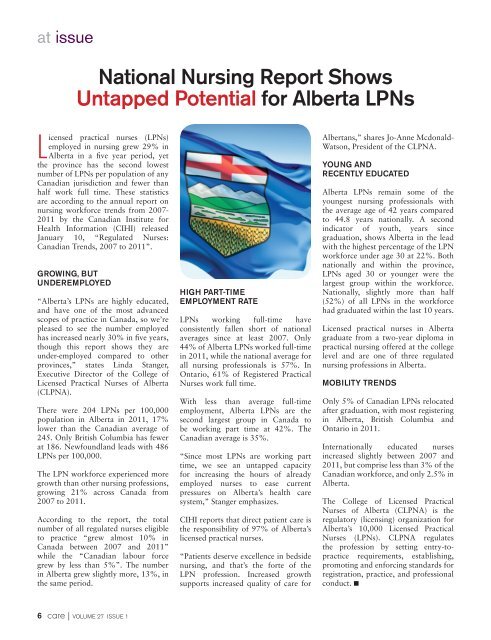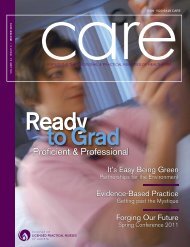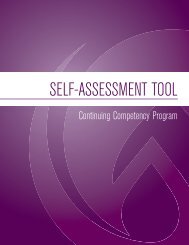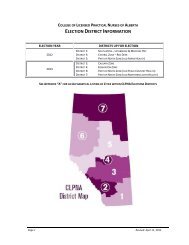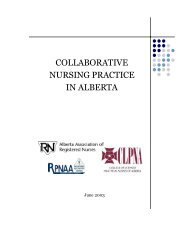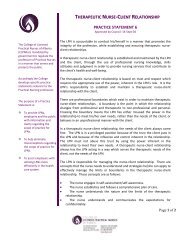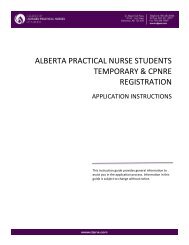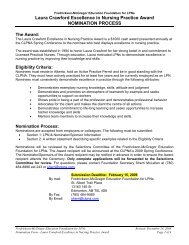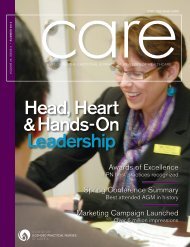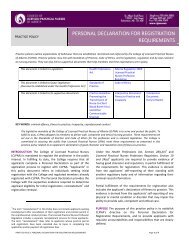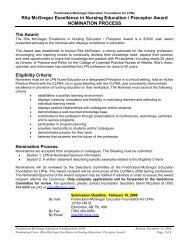Download PDF - College of Licensed Practical Nurses of Alberta
Download PDF - College of Licensed Practical Nurses of Alberta
Download PDF - College of Licensed Practical Nurses of Alberta
- No tags were found...
Create successful ePaper yourself
Turn your PDF publications into a flip-book with our unique Google optimized e-Paper software.
at issueNational Nursing Report ShowsUntapped Potential for <strong>Alberta</strong> LPNs<strong>Licensed</strong> practical nurses (LPNs)employed in nursing grew 29% in<strong>Alberta</strong> in a five year period, yetthe province has the second lowestnumber <strong>of</strong> LPNs per population <strong>of</strong> anyCanadian jurisdiction and fewer thanhalf work full time. These statisticsare according to the annual report onnursing workforce trends from 2007-2011 by the Canadian Institute forHealth Information (CIHI) releasedJanuary 10, “Regulated <strong>Nurses</strong>:Canadian Trends, 2007 to 2011”.GROWING, BUTUNDEREMPLOYED“<strong>Alberta</strong>’s LPNs are highly educated,and have one <strong>of</strong> the most advancedscopes <strong>of</strong> practice in Canada, so we’repleased to see the number employedhas increased nearly 30% in five years,though this report shows they areunder-employed compared to otherprovinces,” states Linda Stanger,Executive Director <strong>of</strong> the <strong>College</strong> <strong>of</strong><strong>Licensed</strong> <strong>Practical</strong> <strong>Nurses</strong> <strong>of</strong> <strong>Alberta</strong>(CLPNA).There were 204 LPNs per 100,000population in <strong>Alberta</strong> in 2011, 17%lower than the Canadian average <strong>of</strong>245. Only British Columbia has fewerat 186. Newfoundland leads with 486LPNs per 100,000.The LPN workforce experienced moregrowth than other nursing pr<strong>of</strong>essions,growing 21% across Canada from2007 to 2011.According to the report, the totalnumber <strong>of</strong> all regulated nurses eligibleto practice “grew almost 10% inCanada between 2007 and 2011”while the “Canadian labour forcegrew by less than 5%”. The numberin <strong>Alberta</strong> grew slightly more, 13%, inthe same period.HIGH PART-TIMEEMPLOYMENT RATELPNs working full-time haveconsistently fallen short <strong>of</strong> nationalaverages since at least 2007. Only44% <strong>of</strong> <strong>Alberta</strong> LPNs worked full-timein 2011, while the national average forall nursing pr<strong>of</strong>essionals is 57%. InOntario, 61% <strong>of</strong> Registered <strong>Practical</strong><strong>Nurses</strong> work full time.With less than average full-timeemployment, <strong>Alberta</strong> LPNs are thesecond largest group in Canada tobe working part time at 42%. TheCanadian average is 35%.“Since most LPNs are working parttime, we see an untapped capacityfor increasing the hours <strong>of</strong> alreadyemployed nurses to ease currentpressures on <strong>Alberta</strong>’s health caresystem,” Stanger emphasizes.CIHI reports that direct patient care isthe responsibility <strong>of</strong> 97% <strong>of</strong> <strong>Alberta</strong>’slicensed practical nurses.“Patients deserve excellence in bedsidenursing, and that’s the forte <strong>of</strong> theLPN pr<strong>of</strong>ession. Increased growthsupports increased quality <strong>of</strong> care for<strong>Alberta</strong>ns,” shares Jo-Anne Mcdonald-Watson, President <strong>of</strong> the CLPNA.YOUNG ANDRECENTLY EDUCATED<strong>Alberta</strong> LPNs remain some <strong>of</strong> theyoungest nursing pr<strong>of</strong>essionals withthe average age <strong>of</strong> 42 years comparedto 44.8 years nationally. A secondindicator <strong>of</strong> youth, years sincegraduation, shows <strong>Alberta</strong> in the leadwith the highest percentage <strong>of</strong> the LPNworkforce under age 30 at 22%. Bothnationally and within the province,LPNs aged 30 or younger were thelargest group within the workforce.Nationally, slightly more than half(52%) <strong>of</strong> all LPNs in the workforcehad graduated within the last 10 years.<strong>Licensed</strong> practical nurses in <strong>Alberta</strong>graduate from a two-year diploma inpractical nursing <strong>of</strong>fered at the collegelevel and are one <strong>of</strong> three regulatednursing pr<strong>of</strong>essions in <strong>Alberta</strong>.MOBILITY TRENDSOnly 5% <strong>of</strong> Canadian LPNs relocatedafter graduation, with most registeringin <strong>Alberta</strong>, British Columbia andOntario in 2011.Internationally educated nursesincreased slightly between 2007 and2011, but comprise less than 3% <strong>of</strong> theCanadian workforce, and only 2.5% in<strong>Alberta</strong>.The <strong>College</strong> <strong>of</strong> <strong>Licensed</strong> <strong>Practical</strong><strong>Nurses</strong> <strong>of</strong> <strong>Alberta</strong> (CLPNA) is theregulatory (licensing) organization for<strong>Alberta</strong>’s 10,000 <strong>Licensed</strong> <strong>Practical</strong><strong>Nurses</strong> (LPNs). CLPNA regulatesthe pr<strong>of</strong>ession by setting entry-topracticerequirements, establishing,promoting and enforcing standards forregistration, practice, and pr<strong>of</strong>essionalconduct. n6 care | volume 27 issue 1


